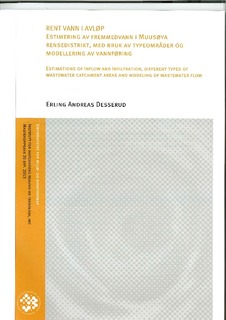| dc.description.abstract | Infiltration and inflow (I/I) is a problem of major importance, with huge costs and major impacts on society. In line with population growth, centralization and climate change, the problem is growing. There is little knowledge about the phenomenon, how it occurs and what factors contribute.
This thesis is an attempt to create a model to calculate I/I on the basis of different types of wastewater catchment areas. The wastewater district of Muusøya, municipality of Drammen, is used as a case study. The wastewater collection system of Muusøya is chaotic, it is difficult to generalize from unique observations to areas of great size, and the wastewater catchment areas that make up the district are inhomogeneous. Nevertheless, it was possible to divide the whole district by categorizing each wastewater catchment area after the prevailing conditions. This led to the following types of wastewater catchments:
Separate sewer system of old age
Separate sewer system of new age
Combined sewer system, old age, residential area
Combined sewer system, new age, residential area
Combined sewer system, downtown or industrial area
The different types of wastewater catchments were then given different settings (in a modeling software) to match the expectation of I/I.
By adding data from measurements of rainfall, temperature, evaporation and estimations of wastewater load, total wastewater is simulated for the period 2007-2011. The simulated flow is compared with measured flow from Muusøya wastewater treatment plant (WWTP). Estimates of I/I is compared with the dilution of phosphorus concentrations, based on initial concentrations and concentrations measured at Muusøya WWTP.
I/I have a huge impact on the flow of wastewater at Muusøya WWTP. Both data from the simulations and the measured concentrations of phosphorus supports this statement. The model indicates that the proportion of I/I is in the range of 79 to 83% of the annual flow at the WWTP. Based on phosphorus concentrations and the dilution that takes place between households and the treatment plant, I/I is estimated between 74.5 and 83.2% of the total annual wastewater, depending on the year in question and the initial values used for calculations.
The model shows that it is possible to simulate wastewater flow for the whole wastewater district based on the different types of wastewater catchments. It must be added that the model is rough and it is difficult to comment on how well the simulation concur with the measured flow. The uncertainty is primarily associated with the fact that one does not know what quantities is lost through overflow or leakage, and the figures used for estimating the losses are of great uncertainty.
//////////////////////////////////////////////////////// Fremmedvann er et stort problem som har store kostnader, store konsekvenser for samfunnet og i takt med befolkningsvekst, sentralisering og klimautvikling, er et tiltakende problem. Det er lite kunnskap om fenomenet, hvordan det oppstår og hvilke faktorer som bidrar.
I denne oppgaven er det forsøkt å bygge en modell for å beregne fremmedvann med utgangspunkt i ulike typer typeområder, det vil si avløpsfelt som av ulike årsaker kan kategoriseres under samme type. Muusøya rensedistrikt i Drammen er benyttet som case. Avløpsnettet i området framstår som kaotisk, det er vanskelig å gjøre generelle betraktninger for større områder, og avløpsfeltene som utgjør distriktet er svært inhomogene. Allikevel lot hele rensedistriktet seg inndele ved å kategorisere hvert avløpsfelt etter hovedvekten av en gitt egenskap. Følgende typeområder ble etablert og benyttet:
Eldre separatsystem
Nyere separatsystem
Eldre fellessystem, boligområde
Nyere fellessystem, boligområde
Avløp felles, sentrum-/næringsområde
De ulike typeområdene er så gitt innstillinger i et modelleringsverktøy i samsvarer med en forventning om fremmedvannsinntrengning.
Ved å legge til data fra målinger av nedbør, temperatur, fordampning samt spillvanns-belastning simuleres avrenningen i distriktet i perioden 2007-2011. De simulerte vannførings-målingene er sammenlignet med målt vannføring ved Muusøya renseanlegg og estimatene av fremmedvann er sammenlignet med fortynning av fosforkonsentrasjoner, også fra Muusøya renseanlegg.
Muusøya rensedistrikt har et meget stort omfang av fremmedvann. Påstanden har dekning både i modellberegninger og konsentrasjonsberegninger. Modellen angir andel fremmedvann å være i spennet mellom 79 til 83 % av årlig vannføring, varierende fra år til år. Basert på fosforkonsentrasjoner og fortynning anslås andel fremmedvann å være mellom 74,5 og 83,2 % av årlig vannføring, avhengig av hvilke år det er snakk om og hvilke initalkonsentrasjoner som benyttes i beregningene.
Modellen viser at det er mulig å simulere vannføringen for et helt rensedistrikt med utgangspunkt i ulike typeområder. Det må legges til at modellen er grov og at det er vanskelig å uttale seg om hvor godt simuleringer treffer. Usikkerheten er først og fremst forbundet med at man ikke vet hvilke mengder vann som går i overløp eller tapes gjennom lekkasje, og de tall som benyttes for å estimere tap er basert på grove beregninger. | no_NO |
